Conference Presentations by Camilla Varming
The influence of different methods of sample preparation on the aroma profiles of dried Roselle (... more The influence of different methods of sample preparation on the aroma profiles of dried Roselle (Hibiscus sabdariffa) was studied. Least amounts of aroma compounds were recovered by analysis of whole dry calyxes (WD) followed by ground dry (GD), blended together with water (BTW), and ground and then mixed with water (GMW). The highest number of aroma compounds was found in Roselle treated in water bath (2hr/40°C) (GMWKB). GMW was chosen as the preparation method because it was shown to be an efficient extraction method without the possibility of excessive chemical changes of the sample.
Papers by Camilla Varming
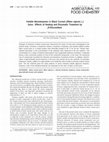
J Agr Food Chem, 2006
Changes of terpenes in black currant juice induced by the action of heat were investigated in the... more Changes of terpenes in black currant juice induced by the action of heat were investigated in the present study. Limonene, R-terpinene, linalool, R-terpineol, 4-terpineol, and menthol added to either black currant juice or a model system were thermally treated at 90°C for 30 min. Similar heatinduced decreases in the concentration of the terpenes were observed in the two systems. The concentration of a range of terpene hydrocarbons and oxygenated terpenes increased, R-terpineol being a main conversion product of most of the examined compounds. In the main, the measured loss of compounds exceeded the detected concentrations of products formed. In addition, determination of glycosidically bound terpenes in the juice was carried out by two methods of enzymatic hydrolysis, namely, addition of -glucosidase to an Amberlite XAD-2 isolate or directly to black currant juice. The two methods gave the same patterns of seven released volatile aglyconic terpenes. However, none of the released terpenes are important for the odor of black currant juice.

LWT - Food Science and Technology, 2015
ABSTRACT In cheese powder production, cheese is mixed and melted with water and emulsifying salt ... more ABSTRACT In cheese powder production, cheese is mixed and melted with water and emulsifying salt to form an emulsion (cheese feed) which is required to remain stable at 60 °C for 1 h and during further processing until spray drying. Addition of emulsifying salts ensures this, but recent demands for reduction of sodium and phosphate in foods makes production of cheese powder without or with minimal amounts of emulsifying salts desirable. The present work uses a centrifugation method to characterize stability of model cheese feeds. Stability of cheese feed with emulsifying salt increased with holding time at 60 °C, especially when no stirring was applied. No change in stability during holding was observed in cheese feeds without emulsifying salt. This effect is suggested to be due to continued exerted functionality of the emulsifying salt, possibly through reorganizations of the mineral balance.
Developments in Food Science, 2006
The release of bound volatile alcohols of blackcurrant juice from the corresponding glycosides wa... more The release of bound volatile alcohols of blackcurrant juice from the corresponding glycosides was studied enzymatically using β-glucosidase in two different ways. The enzyme was added either directly to the juice, or to an extract of glycosidic compounds that had been isolated from the juice by chromatography using Amberlite XAD-2. The two methods resulted in the same patterns of released
Developments in Food Science, 2006
The present paper deals with aroma changes in the production and storage of precooked potatoes, f... more The present paper deals with aroma changes in the production and storage of precooked potatoes, frozen leeks and fruit juices (apple and blackcurrant). In precooked potatoes and frozen leeks development of aliphatic aldehydes results in off-flavours, however, blanching (leeks) and exclusion of oxygen reduce off-flavour formation. In fruit juices high losses of esters and terpenes in the different processing steps
International Journal of Dairy Technology, 2011
Changes in the composition of volatile compounds during processing of cheese powders, made from E... more Changes in the composition of volatile compounds during processing of cheese powders, made from Emmental and Danbo cheese were analysed by dynamic headspace gas chromatography-mass spectrometry.
LWT - Food Science and Technology, 2013
ABSTRACT The aim of the present study was to determine the contents of ascorbic acid in old Danis... more ABSTRACT The aim of the present study was to determine the contents of ascorbic acid in old Danish apple cultivars and in commercially available apple juices. Ascorbic acid was determined using the 2,6-dichloroindophenol method. The ascorbic acid content of the 71 analysed apple cultivars ranged from less than 1 to 27 mg/100 mL, with an average of 6.4 mg/100 mL. Preliminary results showed that upon pressing of apples the ascorbic acid was readily degraded. The levels of ascorbic acid found in the 18 commercial apple juices were negligible, the highest level was 2.6 mg/100 mL, but most were below 1 mg/100 mL. Hence to benefit from ascorbic acid in apples the fruits have to be eaten unprocessed.
International Journal of Dairy Technology, 2011
Volatile compounds in skim milk and nonstandardised milk subjected to instant infusion pasteurisa... more Volatile compounds in skim milk and nonstandardised milk subjected to instant infusion pasteurisation at 80°C, 100°C and 120°C were compared with raw milk, high temperature short time pasteurised milk and milk pasteurised at 85°C ⁄ 30 s. The composition of volatile compounds differed between infusion pasteurisation treated samples and the reference pasteurisations. The sensory properties of skim milk subjected to instant infusion pasteurisation were described by negative attributes, such as cardboard sour and plastic flavours, which are not associated normally with fresh milk. Partial least squares modelling showed good correlation between the volatile compounds and the sensory properties, indicating the predictive and possible causal importance of the volatile compounds for the sensory characteristics.

International Dairy Journal, 2014
ABSTRACT In cheese powder production, cheese is melted with water and emulsifying salt to create ... more ABSTRACT In cheese powder production, cheese is melted with water and emulsifying salt to create an emulsion (denoted cheese feed) that should remain stable until and during spray drying. The aim of this study was to investigate how reduction of emulsifying salt may be compensated for by use of different combinations of cheese types. Cheese feeds were produced at laboratory scale from combinations of Cheddar, Camembert and soft white cheese. Methods for feed characterisation and determination of phase separation of feed were evaluated for applicability to describe the characteristics of the cheese feed. Cheese feed stability generally decreased when the concentration of emulsifying salt was reduced. Emulsion stability of cheese feeds of Cheddar in combination with either soft white cheese or, especially, Camembert were generally higher than for feeds produced with Cheddar only. The functionalities of stabilisation may be related to pH, calcium concentration, level of intact casein and salt-to-moisture ratio.
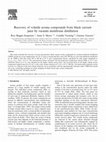
Journal of Food Engineering, 2004
This study evaluated the recovery of seven characteristic black currant aroma compounds by vacuum... more This study evaluated the recovery of seven characteristic black currant aroma compounds by vacuum membrane distillation (VMD) carried out at low temperatures (10-45°C) and at varying feed flow rates (100-500 l/h) in a lab scale membrane distillation set up. VMD at feed flow from 100 to 500 l/h at 30°C gave concentration factors, calculated for each aroma compound as C permeate =C feed , from $4 to 15. The concentration factors increased with decreased juice temperature during VMD; at 10°C concentration factors of 21-31 were obtained for the highly volatile aroma esters. The recovered levels of the highly volatile aroma compounds ranged from 68 to 83 vol.% with a feed volume reduction of 5 vol.% (10°C, 400 l/h). The theoretically predicted aroma recovery as a function of the feed volume reduction was in accordance with the experimentally obtained values. VMD thus turned out to be a promising technique for gentle stripping of black currant juice aroma compounds.
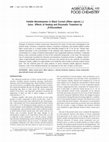
Journal of Agricultural and Food Chemistry, 2006
Changes of terpenes in black currant juice induced by the action of heat were investigated in the... more Changes of terpenes in black currant juice induced by the action of heat were investigated in the present study. Limonene, R-terpinene, linalool, R-terpineol, 4-terpineol, and menthol added to either black currant juice or a model system were thermally treated at 90°C for 30 min. Similar heatinduced decreases in the concentration of the terpenes were observed in the two systems. The concentration of a range of terpene hydrocarbons and oxygenated terpenes increased, R-terpineol being a main conversion product of most of the examined compounds. In the main, the measured loss of compounds exceeded the detected concentrations of products formed. In addition, determination of glycosidically bound terpenes in the juice was carried out by two methods of enzymatic hydrolysis, namely, addition of -glucosidase to an Amberlite XAD-2 isolate or directly to black currant juice. The two methods gave the same patterns of seven released volatile aglyconic terpenes. However, none of the released terpenes are important for the odor of black currant juice.

Journal of Agricultural and Food Chemistry, 2004
The influence of thermal treatment on black currant juice aroma was investigated in temperature a... more The influence of thermal treatment on black currant juice aroma was investigated in temperature and time ranges relevant for black currant juice concentration processes, namely, 45, 60, 75, and 90 degrees C. Forty-nine aroma compounds were quantified, and the thermal treatment resulted in concentration increases of most terpenes, aldehydes, furans, and phenols, whereas the concentration of esters slightly decreased. Higher temperatures and longer exposure times had larger effects on the aroma compounds. Odor triangle tests showed no sensory difference between pasteurized juice and juice heated at 60 degrees C, whereas juice heated at 90 degrees C differed significantly from pasteurized juice. It is concluded that a 90 degrees C thermal treatment of black currant juice, which is in the temperature range used for conventional evaporation of black currant juice, has an effect on the aroma and sensory properties.
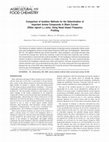
Journal of Agricultural and Food Chemistry, 2004
The influence of isolation method on the determination of important aroma compounds in black curr... more The influence of isolation method on the determination of important aroma compounds in black currant juice was investigated by surface of nasal impact frequency (SNIF) gas chromatography-olfactometry (GC-O). The applied methods were solvent extraction, static headspace, and purge and trap using 15 and 60 min of purge time. By the four methods, a total of 59 odors were observed, and, of these, 44 corresponded to compounds that could be identified. For the headspace methods increasing purge volumes resulted in recoveries of additional, less volatile compounds. The main compound groups recovered by the headspace methods were esters and terpenes, whereas compounds recovered by solvent extraction were not as dominated by fruity odors. For most compounds there was agreement between the size of the SNIF value obtained by GC-O and the amount of the measurable compound found by gas chromatography-mass spectrometry.
International Dairy Journal, 2013
Quantification of 62 aroma compounds in three commercial semi-hard cheeses with different fat con... more Quantification of 62 aroma compounds in three commercial semi-hard cheeses with different fat contents and maturity levels was pursued. Dynamic headspace sampling and gas chromatographyemass spectrometry (GCeMS) was applied after spiking each of the three cheeses with the aroma compounds, and PARAllel FACtor analysis was used to resolve co-eluting compounds. By the use of linear regression, half of the spiked aroma compounds exhibited similar slopes in the three cheeses whereas the volatilities of 15 other compounds were dependent on their hydrophilicity relative to the fat content of the cheese. For nine aroma compounds, satisfactory coefficients of determination were obtained in one or two of the cheeses only, and seven compounds could not be quantified at all.

International Dairy Journal, 2013
ABSTRACT Three types of cheese powders made from well-matured smear-ripened, hard, or blue cheese... more ABSTRACT Three types of cheese powders made from well-matured smear-ripened, hard, or blue cheese, were subjected to sensory profiling and analysis of volatiles, key aroma compounds, amino acids and organic acids. Blue cheese powders had high flavour intensities, especially of ‘fruity’ and ‘blue’ odour and flavour, which were related to a high content of methyl ketones and alcohols, esters and free fatty acids typically produced by Penicillium species. Smear cheese powders, characterised by ‘smear’ odour and flavour, were associated with flavour compounds derived from catabolism of sulphuric and branched-chain amino acids. Hard cheese powders described by ‘Goya’ odour and flavour as well as ‘umami’, ‘harmony’ and ‘kokumi’, had low or medium amounts of most compounds. The different characteristics of the three cheese powders can make them useful in different food applications as flavours or flavour enhancers.
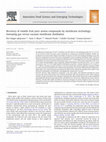
Innovative Food Science & Emerging Technologies, 2011
The influence of temperature (10-45°C), feed flow rate (300-500 L/h) and sweeping gas flow rate (... more The influence of temperature (10-45°C), feed flow rate (300-500 L/h) and sweeping gas flow rate (1.2-2 m 3 /h) on the recovery of berry fruit juice aroma compounds by sweeping gas membrane distillation (SGMD) was examined on an aroma model solution and on black currant juice in a lab scale membrane distillation set up. The data were compared to recovery of the aroma compounds by vacuum membrane distillation (VMD). The flux of SGMD increased with an increase in temperature, feed flow rate or sweeping gas flow rate. Increased temperature and feed flow rate also increased the concentration factors (C permeate /C feed ) of the aroma compounds. At 45°C the most volatile and hydrophobic aroma compounds obtained the highest concentration factors: 12.1-9.3 (black currant juice) and 17.2-12.8 (model solution). With black currant juice a volume reduction of 13.7% (vol.%) at 45°C, 400 L/h, resulted in an aroma recovery of 73-84 vol.% for the most volatile compounds. Compared to VMD, the aroma recovery with SGMD was less influenced by the feed flow rate but more influenced by the temperature. Higher fluxes were achieved during concentration by VMD and this reduced the operation time, which in turn reduced the degradation of anthocyanins and polyphenolic compounds in the juice. Industrial relevance: High temperature evaporation is the most widely used industrial technique for aroma recovery and concentration of juices, but membrane distillation (MD) may provide for gentler aroma stripping and lower energy consumption. This study gives important clues about the fate of berry juice aroma compounds and polyphenols during concentration by MD, and identifies the main factors influencing the aroma recovery efficiency with MD. Both SGMD and VMD are promising techniques for gentle stripping of berry juice aroma compounds and deserve further consideration as alternative techniques for gentle aroma stripping in industrial fruit juice processing.
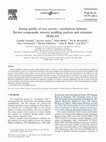
Food Quality and Preference, 2004
Sensory profiling, analysis of aroma, sugar and dry matter, as well as consumer liking test were ... more Sensory profiling, analysis of aroma, sugar and dry matter, as well as consumer liking test were used to characterise the quality of six carrot cultivars, grown at two locations in Denmark. The carrot samples were examined at harvest, and after three months of cold storage. Carrot cultivar had an effect on most sensory and flavour compound variables, due particularly to the influence of one cultivar; and also location influenced carrot quality. Storage of carrots was characterised by an increase of a range of aroma components, but the changes in flavour compounds were not correspondingly observed by the sensory analysis. By Partial Least Squares Regression (PLSR) two thirds of the flavour compound variables was found to correlate significantly with one or more of the nine sensory attributes; and all of the sensory attributes were significantly correlated with one or more of the consumer liking test variables bitterness, sweetness and liking.

Uploads
Conference Presentations by Camilla Varming
Papers by Camilla Varming